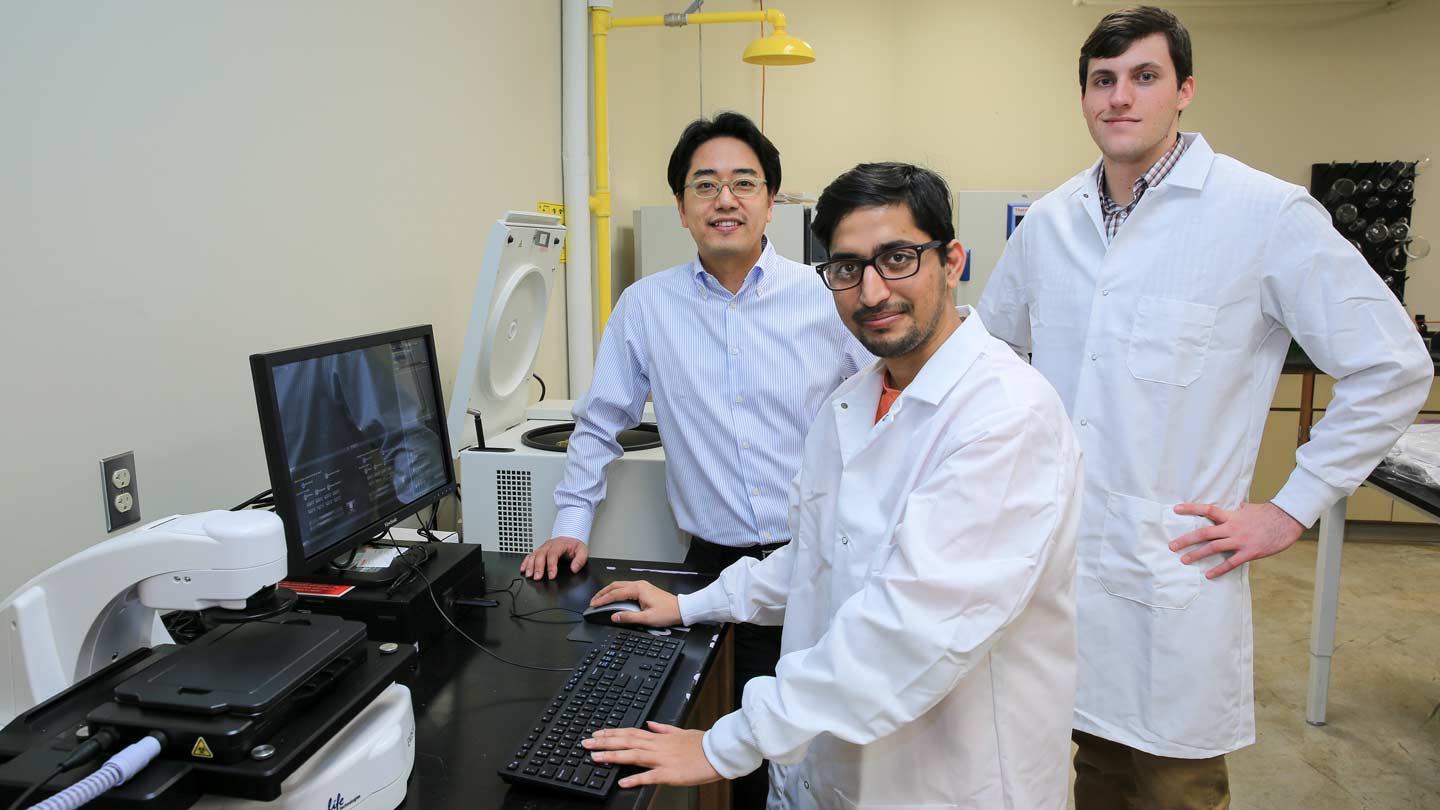
Michael Mercier | UAH
The world of science and engineering became magical when young Kyung-Ho Roh began building complex structures with Legos and plastic model kits.
"At some point, I became interested in materials around us, which I believe, somehow influenced my decision to pursue my undergraduate degree in Fiber and Polymer Science and Engineering," said Roh, an Assistant Professor in the UAH Department of Chemical and Materials Engineering. "During my master's thesis, I became fascinated by the fact that polymer engineering can contribute to innovation in medicine, for example, in drug delivery and in tissue regeneration. The idea that I can contribute to the world by developing strategies to alleviate the pain and suffering of many people still fascinates me."
Roh grew up in Seoul, South Korea, where he graduated from Sangmoon High School and earned bachelor's and master's degrees in Fiber and Polymer Science and Engineering from Seoul National University. After completing mandatory military service, Roh gained invaluable research experience while working at the Korea Institute of Science and Technology as a junior researcher. A year later, he came to the United States to pursue a PhD at The University of Michigan in Ann Arbor.
"In my undergraduate and graduate research in Fiber and Polymer Science and Engineering, I learned about the basic principles to synthesize, characterize, and manufacture a variety of organic materials. Organic fibers and polymers are everywhere around us, in clothes, plastic bags, furniture, interior and exterior of buildings, electronics, cars, airplanes, etc.," Roh said. "In fact, many components in our body such as proteins, polysaccharides, and nucleic acids (DNAs and RNAs) are all natural polymers."
Roh was initially drawn to UAH seeking a tenure-track professorship. But the more he learned about the Rocket City, the more he was attracted to the unique aspects of the university and its research-rich community.
"The university is traditionally strong in teaching and research in engineering disciplines and UAH defined Biotechnology as one of the areas of focused support in its strategic plan," Roh said. "Applying engineering principles for biotechnology is my ongoing research interest, UAH certainly felt like the place that I can contribute to with my research and teachings. The presence of HudsonAlpha Institute for Biotechnology also encouraged me to start my research program here at UAH, making my vision for the pursuit of ever-growing ties and collaborations with the national and world leaders in biotech research."
At UAH, Roh teaches several classes including Polymer Engineering and Bioseparations. "As polymer and bioseparation are closely related to my previous trainings and ongoing research interests, I’ve been really enjoying teaching these classes. From teaching activities, I find that I am learning tons, too…not only about the science itself, but also about how to communicate. I hope my teaching skills only improve as time goes by, so that I can become a more effective engineering educator."
Before arriving at UAH, Roh served as a Research Scientist in The Wallace H. Coulter Department of Biomedical Engineering at Georgia Tech and Emory University. Before then, he conducted research studies at Stanford University and Howard Hughes Medical Institute.
During his postdoctoral research, Roh studied about the mechanism behind how T cells recognize a special pathogenic antigen, activate, and function. At Georgia Tech, Roh started applying biomaterials design for engineering of functional B cells, another type of immune cells that provide antigen-specific immune protection for humans. "Now I am trying to use my polymer engineering principles to guide and train these special immune cells for a variety of therapeutic purposes, so called, cellular immunotherapy."
In his research laboratory at UAH, Roh and his students are continuing to learn how to make these immunotherapy processes more efficient and effective, until those strategies can be used in clinics to help patients. "The UAH College of Engineering has been superb in morally and financially supporting me to relocate and establish my research lab here at the university. I have no doubt that we can continue to grow our research activities rapidly and steadily. Great things are bound to happen!"
Roh notes that there are many ways to functionalize synthetic and natural polymers to be used in biomedical applications. "In particular, I am interested in developing novel strategies to employ these polymers to provide specialized biological signals to a targeted population of our immune cells. For example, among many immune cell compartments, T cells can be regarded as a conductor of an orchestra. By use of polymeric biomaterials as a delivery vehicle of biological compounds (e.g. cytokines) to T cells, or as a scaffold in which the T cells are cultured, activated and functionalized outside of our bodies, we can develop very unique ways to tackle diseases like malicious and tenacious infections, cancers, and autoimmune diseases," he explained.